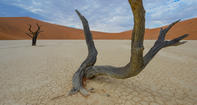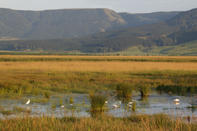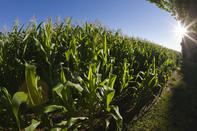Droughts

Drought has been the mainstay behind food insecurity and famine in Africa during the past three decades, which does not bode well for the region in a changing climate. While the global trend for per capita food production goes up elsewhere, across Africa it has been declining for the past two decades.
This, combined with the fact that more than half of the continent's population subsists off the land, has resulted in 'widespread malnutrition, a recurrent need for emergency food aid, and increasing dependence on food grown outside the region'. The World Resources Institute reported in 1998 that food consumption across the region exceeded production by 50 per cent in the drought-prone mid-1980s and by 30 per cent in the mid-1990s.
Now add climate change to the equation. No matter how good all the technical advances brought by the Green Revolution, food production is still dependent on water, soil moisture, nutrients and temperature - at least three of which factors will change in the near future.
A change of up to 1°C could result in greater productivity at the higher latitudes globally, depending on the crop type, growing season, changes in temperature regimes and seasonality of precipitation. But crops grown in the tropics and subtropics are already close to their maximum temperature tolerances - a temperature increase of just 1°C will compromise their annual yield. An increase of more than 2.5°C would increase world food prices.
This amount of warming would also diminish any improved productivity experienced in the middle to high latitudes, while the tropics and subtropics would see a more severe decrease in productivity. Undernutrition is a fundamental cause of stunted physical and intellectual development in children, low productivity in adults, and susceptibility to infectious disease in everyone.
Decreases in food production and increases in food prices associated with climate change would increase the number of undernourished people.
Water Resources

Most of the creeping hunger will be in the developing world. South Africa is precariously arid, but shifts unexpectedly between extremes of drought or flood, with rain falling erratically in different regions and between years. Even without climate change, the country is expected to use up its available surface water by 2030. With climate change, rainfall will become even more unpredictable, possibly changing in its intensity as well as the seasons in which it falls. This will, of course, reflect in the amount of water running off into streams and rivers, and the replenishment of groundwater.
Temperature increases will leave the atmosphere thirsty for water. Greater amounts of evaporated water are expected to be sucked up from dams and soils by the atmosphere and transpiration will increase in plants.
Maize Growth

The only crop that has been studied as part of South Africa's climate change modelling is maize which, in 1996, accounted for 71 per cent of grain harvested that year and 58 per cent of land under crop. Arguably South Africa's most important grain product, 60 per cent of maize grows in the drier western part of the country's maize region and 40 per cent in the wetter east.
The most abundant regions occur in the Free State and North West provinces, followed by the Mpumalanga Highveld and KwaZulu-Natal.
The population of South Africa, Swaziland and Lesotho - where the staple food is maize - is expected to climb from the current estimate of around 45 million to about 70 to 90 million by 2035. In the hotter, drier climate predicted by climate models, annual yields will drop between ten and twenty per cent by 2050, even though the region requires an annual three per cent increase to meet its future food requirements.
The marginal western plantings are expected to suffer most, while the wetter eastern range of maize will be least affected. Various adaptation mechanisms have been suggested: farmers could change their crops to more drought- resistant species such as millet or sorghum, or they could shift from crops to livestock farming. South Africa certainly cannot hope to lean on its water supply to save its maize crops.